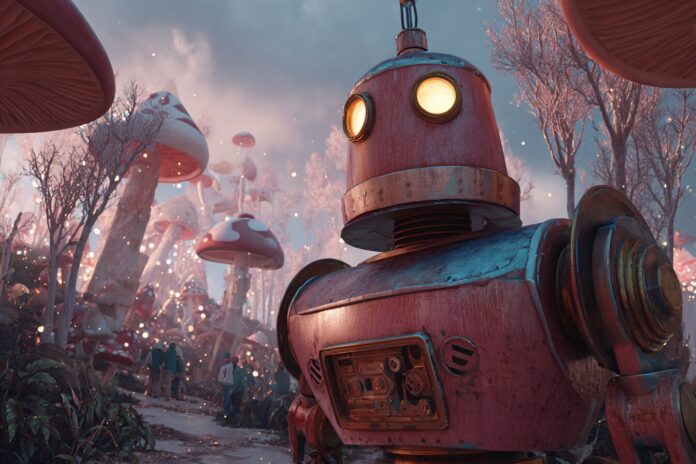Disney characters have long enchanted audiences by bringing fantastical tales to life. However, as technology evolves, traditional narratives are being challenged by artificial intelligence. The recent surge in AI-generated content, including the notorious ‘Wall-E With a Gun,’ has ignited a fervent legal debate. This debate is not merely about image reproduction but touches on fundamental issues of creativity, copyright, and the ethical use of technology.
Unprecedented Imagery and its Viral Impact
Because the sight of Wall-E, typically known as a kindhearted, hardworking robot, wielding a gun is both shocking and thought-provoking, it has quickly captivated the online world. Such images, spawned from the advanced algorithms of Midjourney, illustrate how generative AI tools can produce unexpected and sometimes unsettling modifications of beloved characters. Most importantly, these reimagined visuals have sparked public discourse about the extent to which artificial intelligence should be allowed to manipulate well-known cultural icons.
Besides that, the phenomenon has spread rapidly across various social media platforms, prompting fans and critics alike to debate the creative freedom of AI. For instance, platforms like Time have highlighted the transformative impact of these images on popular art, while others point to the legal consequences as detailed in Axios. Therefore, this trend signifies a paradigm shift in how art is created and consumed in the digital age.
The Landmark Lawsuit: A Battle for Creative Control
On June 11, 2025, the legal landscape witnessed a groundbreaking moment when Disney and NBCUniversal initiated a comprehensive copyright infringement lawsuit against Midjourney. The studios argue that the AI platform systematically scraped millions of copyrighted images, including iconic works owned by Disney and Universal. This aggressive approach to content generation has provoked significant concerns about unauthorized use and the violation of intellectual property rights.
Moreover, legal experts have noted that this case is likely to reshape the principles of fair use within the context of artificial intelligence. As highlighted by AccelerateIP, the lawsuit not only challenges the operational framework of Midjourney’s image generator but also sets a precedent for future disputes over AI-generated content. Most importantly, the studios seek statutory damages of up to $150,000 per infringed work, with over 150 works under scrutiny, summing up to more than $20 million in potential penalties.
Ethical and Legal Dimensions of AI Art
In the wake of this lawsuit, multiple ethical concerns have emerged regarding the data scraping methods used by AI companies. Critics argue that AI platforms like Midjourney function as a “virtual vending machine,” offering unfiltered outputs based on massive, unsorted datasets. As stated by Cartoon Brew, the process ignores the significance of protecting original art and discourages compensating the original creators.
Therefore, the case propels a critical reassessment of both existing copyright laws and the ethical boundaries of AI innovation. Because the dispute touches on the core of ownership and originality, industry insiders predict sweeping changes, such as the development of stricter copyright filters and redefined licensing agreements. This transformation is poised to not only affect Midjourney but also set a global benchmark for managing AI-generated content.
Midjourney’s Stance and the Road Ahead
Despite the intense legal pressures, Midjourney has maintained a notably silent stance regarding the allegations. Previous statements from its founder, David Holz, have surprisingly dismissed the issue as an inadvertent byproduct of the vast, uncurated image scraping process. This laissez-faire approach has only deepened the divide between creative innovators and traditional rights holders.
Because the lawsuit continues to unfold, it remains unclear how Midjourney will adapt its operational practices, if at all. Nevertheless, the extensive legal scrutiny is developing into a bellwether case in the field of generative AI. Most importantly, it prompts both regulatory bodies and technology companies to reconsider how intellectual property rights are protected in an era dominated by rapid technological advances.
Defining the Future of Creativity and Copyright
Looking forward, this dispute serves as a crucial turning point for the creative and technological sectors. The outcome will likely influence not only the practices of AI developers but also legal interpretations of fair use and copyright. Because moderators in legal, technological, and creative industries are now actively seeking solutions, the future may involve more collaborative efforts between AI companies and rights holders.
Additionally, this case invites artists, creators, and tech enthusiasts to engage in a broader dialogue about balancing technological innovation with the protection of traditional creative works. Therefore, as videos and images become increasingly AI-generated, the industry must determine a sustainable path that respects both innovation and intellectual property. More insights on this evolving scenario can be found in comprehensive analyses available on platforms like YouTube.
In conclusion, the Disney and Universal lawsuit against Midjourney is not only a legal battle but also a cultural turning point. With significant financial stakes and philosophical implications, the case continues to provoke robust debates about the role of AI in art and its impact on creative originality.
References:
1. Time
2. Axios
3. AccelerateIP
4. Cartoon Brew
5. YouTube



